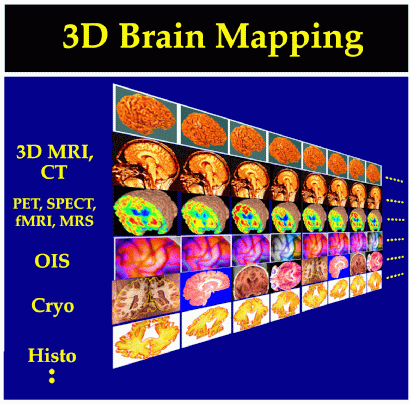Arthur W. Toga and Paul M. Thompson
Laboratory of Neuro Imaging, Department of Neurology, Division of Brain Mapping, UCLA School of Medicine, Los Angeles, California 90095

Our ability to acquire extraordinary images of the brain has been and is progressing at an astonishing rate. Interpretation of these images often requires comparison with others of similar type. Questions such as: What is this anatomic feature? Where is this region of functional activation? How different is this brain compared with the normal database? - can only be answered in consultation with a map or atlas. Creating maps and atlases increasingly relies on the accumulation and compilation of many image sets (Toga and Mazziotta, 1996) along with appropriate registration and warping strategies (Toga, 1998), indexing schemes and nomenclature systems. The processing of images in the context of a map or atlas enables a more meaningful interpretation. It is this comparison with maps or atlases from multiple modalities and individuals that now provides our remarkable ability to describe image data with statistical and visual power.
Efficient collection of normal and diseased brain images in vivo and ex vivo provides the fodder for a tremendous increase in the number of investigations focusing on the structural and functional organization of the brain. The complexity and variability of human brain (as well as other species) across subjects is so great that reliance on maps and atlases is essential to effectively manipulate, analyze and interpret brain data. Central to these tasks is the construction of averages, templates and models to describe how the brain and its component parts are organized. Design of appropriate reference systems for human brain data presents considerable challenges, since these systems must capture how brain structure and function vary in large populations, across age and gender, in different disease states, across imaging modalities, and even across species.
This chapter introduces the topic of brain maps as applied to a variety of questions and problems in health and disease. It includes a brief survey of the types of maps and to what questions they are applied. First, there is an overview of the subject brain mapping, describing the elements of a map as distinct from an image. Next there is a discussion of coordinate systems and how they reference source data from individuals, followed by a description of deformable atlases and how they can adapt to and measure variability across subjects and systems. Finally, maps are covered that describe relationships between different observations, such as across modalities or with a changing morphology, as are the categorization of subpopulations and interspecies relationships.
To obtain a reprint of our chapter, please send me an e-mail, and I'll be happy to send you a copy!
Key Words: Brain Mapping, 3D, atlases, methods
Paul Thompson
| RESUME| E-MAIL ME| PERSONAL HOMEPAGE| PROJECTS |
|---|